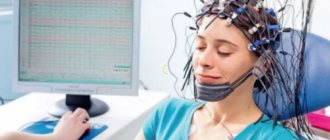Features of the disease
In medical practice, epilepsy is a complex neurological disease accompanied by sudden seizures and seizures. The disease is characterized by the fact that during an attack a person does not realize what is happening to him. As a result, patients do not remember the seizures, do not understand the degree of their intensity and are not able to describe what happened to them.
Temporal lobe epilepsy is one of the most common forms of the disease. This type of disease is accompanied by partial epileptic seizures of varying severity. The progression of pathology in the absence of adequate therapy threatens the occurrence of generalized seizures, as well as the development of various mental disorders and deformations.
There is also a classification of temporal lobe epilepsy, according to which there are 4 types of pathology, depending on the location of the epileptic focus:
- amygdala;
- hippocampal;
- lateral;
- opercular.
Features of temporal lobe epilepsy
Epilepsy of the temporal region is a type of disease, the name of which makes it clear which structural area of the brain is affected. When the disease occurs, epi-seizures of a partial nature occur. They can be simple or complex.
As the disorder progresses, mental disorders or secondary generalized seizures may develop. To understand what is happening with the patient, the doctor studies the complaints and conducts a comprehensive diagnosis. During therapy, pharmacological drugs are mandatory. Without them, it is impossible to stabilize the patient's condition.
Causes of temporal lobe epilepsy
As is the case with other forms of the disease, the main reason for the development of temporal lobe epilepsy is the formation of an epileptic focus in the brain. In this case, the pathological area is a certain area of the temporal lobe. An epileptic seizure is triggered by a sudden surge of excessive neuronal activity in the temporal lobe of the brain.
Today, doctors identify a lot of factors that predispose to the development of temporal lobe epilepsy, dividing them into two broad groups:
- Perinatal - have a negative effect on the brain during intrauterine development or labor. The group of perinatal factors includes various forms of fetal hypoxia, injuries received during childbirth, infectious diseases suffered by the mother during pregnancy, asphyxia in newborns, etc.
- Postnatal – acquired factors of a postnatal nature are much more numerous and varied. Among the most common are traumatic brain injuries, consequences of ischemic or hemorrhagic stroke, brain tumors, abscesses, aneurysms and various neuroinfections).
Signs of violation
The first symptoms of the disease usually appear between six months and six years of age. Then, for about two to five years, the pathology may not manifest itself in any way. The period of calm is followed by a stage of obvious afebrile attacks. They can be:
- Simple. Consciousness is preserved. With motor symptoms, a person begins to turn his head and eyes towards the epileptic focus. By observing the progression of this symptom, the doctor can understand where exactly the affected area is located. Sensory anomalies affect taste and olfactory sensations, contribute to the manifestation of visual and auditory hallucinations, and dizziness. With simple attacks, vestibular ataxia often occurs. They are combined with the illusion of changing the world around us. Sometimes cardiac, respiratory and epigastric somatosensory paroxysms occur. When faced with them, the patient complains of bloating/compression in the chest area, a lump in the throat, suffocation, difficulty breathing, and inexplicable fear. Phenomena of derealization and depersonalization are possible. In the first case, a person perceives familiar things as “never seen”; in the second, he identifies himself with some fictional character and begins to behave very strangely.
- Complex partials. Consciousness turns off, reactions to external stimuli are temporarily blocked. Motor activity may stop. Then the patient freezes and then slowly falls (without convulsions). On the eve of an attack, some patients smack their lips and make unusual sucking and swallowing movements. They may also frown, laugh unnaturally, stomp around, clap their hands, hiss, sob, and repeat unclear sounds over and over again.
- Secondary generalized. Diagnosed if temporal lobe epilepsy progresses rapidly. They are characterized by loss of consciousness, clonic-tonic convulsions in all muscle groups.
In almost all patients, attacks are of a mixed nature. If you delay treatment, a person will face intellectual-mnestic anomalies and emotional-personal disorders. Then it will be much more difficult to correct the situation.
Often temporal lobe epilepsy leads to neuroendocrine disruptions. Thus, women may have menstrual irregularities, decreased fertility, and men may have impotence and problems with ejaculation. In rare cases, the diagnosis causes the manifestation of symptoms of osteoporosis and hypothyroidism.
Clinical picture
The main clinical sign of temporal lobe epilepsy is epileptic seizures. They arise suddenly and are expressed in the patient’s unconsciousness, loss of orientation, muscle cramps, etc. In this case, a characteristic feature is the fact that during a seizure the patient turns his head and squints his eyes towards the temple in which the area of epileptic activity is concentrated.
Other symptoms of temporal lobe epilepsy include:
- frequent, even systematic dizziness;
- headaches and migraines;
- visual and auditory hallucinations;
- olfactory paroxysms;
- squeezing or bursting sensation in the heart area;
- coordination problems;
- various forms of mental disorders;
- automation of gestures and sounds;
- personality distortions, etc.
General information about temporal lobe epilepsy
Symptoms of the temporal lobe disease occur in children and adults more often than other forms. According to statistics, damage to the brain area of the temples is found in approximately 25% of all cases of epileptic seizures.
Many scientists have tried to thoroughly study this disorder. A breakthrough in diagnostic work was achieved when magnetic resonance imaging became widespread. Today doctors know why this disease occurs, what its consequences are and how to treat it correctly. All that is required of patients is to seek medical help in a timely manner and strictly follow all prescriptions.
Diagnostics
To make an accurate diagnosis, the doctor must compare a lot of factors. The primary diagnosis of temporal lobe epilepsy includes recording symptoms, frequency of attacks, drawing up a detailed medical history, and identifying possible causes or factors in the development of the disease.
Based on the data obtained during the initial diagnosis, the doctor determines the necessary laboratory and hardware tests:
- MRI of the brain;
- PET CT;
- electroencephalography;
- polysomnography.
Diagnosis of the disease
Examination in the best specialized clinics takes a comprehensive approach, and the use of high technology makes it possible to diagnose the disease in the most difficult cases. Standard examination programs include EEG (electroencephalography), blood and urine tests. To clarify the diagnosis, the following are prescribed:
- MRI and CT are mandatory examinations, carried out to exclude organic brain lesions and detect the presence of tumors, vascular malformations, atrophic changes in the frontotemporal lobe;
- polysomnography with a sleep deprivation test determines the pathological activity of brain structures.
Treatment
A complete recovery of the patient, that is, a complete absence of epileptic seizures throughout his life, is extremely difficult to achieve, and in some cases impossible. When resorting to conservative therapy, the main task that doctors set for themselves is to reduce the frequency of attacks and other manifestations of the disease to a minimum.
Conservative treatment of temporal lobe epilepsy involves the prescription and administration of antiepileptic drugs.
During drug therapy, the doctor systematically monitors the patient’s condition and progress from taking the prescribed medication. If undesirable side effects occur, treatment is adjusted, the drug is replaced, or additional symptomatic therapy is provided.
If no positive dynamics are observed from conservative therapy over a long period of time, surgical treatment of temporal lobe epilepsy may be required. For this purpose, experienced neurosurgeons are involved; the following operations for temporal lobe epilepsy are performed:
- temporal resection;
- focal resection;
- selective hippocampotomy;
- amygdalotomy.
Our clinic has everything necessary for accurate diagnosis, effective and comfortable treatment of patients with epileptic seizures. Patients with attacks of loss of consciousness are treated by neurologist-epileptologist Maxim Anatolyevich Palagin.
Drug treatment
Conservative therapy consists of the use of drugs carbamzepine, phenytoin, valproate, barbiturates. Treatment begins with monotherapy - a dose of carbamzepine is prescribed, which is gradually increased to 20 mg, in some cases - up to 30 mg per day. If the patient's condition does not improve, the dose can be increased until results improve or signs of intoxication appear (while taking the drug, doctors monitor the concentration of carbamzepine in the patient's blood). In difficult cases of secondary generalized attacks, the drug diphenin or depakine (valproate) is prescribed. Doctors believe that the effect of valproate is better than diphenine, especially since the second has a much more toxic effect on the body, especially on the cognitive system.
There is the following system of priority for prescribing medications for temporal lobe epilepsy:
- carbamzepine;
- valproates;
- phenytoin;
- barbiturates;
- polytherapy (using basic antiepileptic drugs);
- lamotrigine;
- benzodiazepine.
Polytherapy is used only if monotherapy is ineffective. Multiple combinations of basic and reserve antiepileptic drugs are possible. A reduction in attacks is observed when taking phenobarbital with diphenine, but this combination can significantly affect the central nervous system, having an inhibitory effect that provokes ataxia, decreased cognitive function, memory impairment, and has a negative effect on the gastrointestinal tract.
Drug therapy requires lifelong medication and careful monitoring by doctors. In approximately half of the cases, it is possible to completely stop the attacks with the help of properly selected medications.
Our specialists
Yushina Maria Alexandrovna
Head of the Center for Epilepsy and Paroxysmal Conditions.
The doctor is a neurologist. Epileptologist. Ozone therapist. Physiotherapist Experience: 7 years.
Kordonskaya Irina Sergeevna
Pediatric neurologist of the highest category. Epileptologist. Neurophysiologist (EEG diagnostic doctor). Experience: 24 years.
Volkova Svetlana Anatolevna
Head of the Center for Parkinsonism and Extrapyramidal Diseases.
The doctor is a neurologist of the highest category. Epileptologist. Ozone therapist. Physiotherapist. Experience: 26 years.
Derevianko Leonid Sergeevich
Head of the Center for Diagnostics and Treatment of Sleep Disorders.
The doctor is a neurologist of the highest category. Vertebrologist. Somnologist. Epileptologist. Botulinum therapist. Physiotherapist. Experience: 23 years.
Tarasova Svetlana Vitalievna
Expert No. 1 in the treatment of headaches and migraines. Head of the Center for the Treatment of Pain and Multiple Sclerosis.
Somnologist.
Epileptologist. Botulinum therapist. The doctor is a neurologist of the highest category. Physiotherapist. Doctor of Medical Sciences.
Experience: 23 years.Palagin Maxim Anatolievich
The doctor is a neurologist. Somnologist. Epileptologist. Botulinum therapist. Physiotherapist. Experience: 6 years.
Read also
Epilepsy
These are epileptic seizures that occur repeatedly, regardless of any cause, and are associated with chronic illness of the cerebral cortex.
Epilepsy is a very common disease. Approximately… Read more
Epilepsy and pregnancy
Managing patients with epilepsy and pregnancy is incredibly complex and challenging. What are the features of pregnancy in patients with epilepsy? In 1-2% of cases there is a chance of developing epileptic...
More details
Symptoms of epilepsy
How does epilepsy manifest? The most “famous” epileptic attack is a convulsive one, as the most “bright” one, this attack includes general tonic-clonic seizures, blueness of the face, salivation, ...
More details
Treatment of epilepsy in Samara
Epilepsy therapy is a long process and requires interaction between the epileptologist and the patient. Currently, it is possible to stop attacks and achieve remission in 60%! How to do it? Basic…
More details
Causes of epilepsy
“Where did my seizures come from? There are no epileptics in our family!” - the most common phrase at the reception, we will tell you about the causes of epilepsy. Indeed, up to 70% of all epilepsies are genetically predetermined...
More details
Traditional ideas that epilepsy is a chronic disease characterized by a gradual increase in the severity and frequency of paroxysms and deepening personality changes have been revised in recent decades. It has been established that the course and outcome of epilepsy are very diverse. In some cases, the disease process becomes progressive, and sometimes ends in dementia. However, along with severe cases of epilepsy, there are also relatively favorable options with long-term remissions, and sometimes with practical recovery. Depending on the rate of increase in paroxysmal activity and the deepening of mental changes, slowly and acutely current forms were distinguished [Mnukhin S.S., 1933]; slow, subacute, combined and remitting types of course [Polibina M.N., Shubina S.A., 1939]; continuous-progressive, remitting and stable type of course [Sukhareva G. E., 1955].
The severity of an epileptic disease is determined by the interaction of three main groups of factors: 1) localization and activity of the epileptic focus; 2) the state of the protective and compensatory properties of the body, its individual and age-related reactivity; 3) the influence of external environmental factors. There is also no doubt that the course of the disease is largely determined by the time of its onset, the regularity and adequacy of antiepileptic treatment and rehabilitation measures.
The localization of the epileptic focus is of great importance for the formation of the clinical picture and course of the disease. In accordance with this, some clinical forms of epilepsy are distinguished - temporal, diencephalic, etc.
Temporal lobe (psychomotor) epilepsy.
In this form of the disease, the epileptic focus in the temporal lobe of the brain is not always manifested by anatomical changes.
The clinical features of temporal lobe epilepsy are well defined. Seizures begin with a pronounced aura. As a rule, this is a sensory aura such as senestopathic, olfactory, as well as a complex mental aura, mainly in the form of verbal hallucinosis or states with a sharp change in the perception of the environment. It appears to patients as alienated, frightening, threatening, sometimes comical, unreal, and unclear.
Another clinical feature of temporal lobe epilepsy is non-convulsive paroxysms with various variants of twilight states, in particular in the form of phenomena of mental automatism, as well as the occurrence in these patients of conditions psychopathologically similar to the aura preceding convulsive paroxysms. A. Matthes (1977) describes paroxysms in temporal lobe epilepsy in the form of more or less complex motor acts, often with aggressiveness, affective disorders, and autonomic disorders; Moreover, in some cases, automatisms were combined with tonic convulsions or a sharp decrease in muscle tone.
The presence of the described paroxysmal states without stupefaction, nonconvulsive paroxysms with twilight disorder of consciousness, and the development of twilight states after seizures made it possible to call this variant of the disease “psychomotor epilepsy.” Characterizing the course of such epilepsy, A. Matthes emphasizes the periodicity of attacks, their highest frequency at the age of 20-40 years, the combination of the described paroxysms with typical convulsive seizures during the first 3 years of the disease. As already mentioned, many authors [Sukhareva G. E., 1974; Gastaut H. et al., 1956, 1959, etc.] believe that temporal lobe epilepsy is accompanied by the most profound and typical personality changes.
Diencephalic (vegetative) epilepsy.
This form of the disease is studied mainly by neuropathologists, but patients with diencephalic epilepsy often end up as patients in psychiatric dispensaries and hospitals.
In the structure of periodically occurring paroxysms in diencephalic epilepsy, the main place is occupied by various autonomic disorders [Itsenko N. M., Grinshtein A. M., Davydenkov S. N., 1937; Kulkova-Davidenkova E.F., 1958, etc.].
Paroxysms in vegetative (diencephalic) epilepsy go through several successive stages [Kulkova-Davidenkova E.F., 1958]. Paroxysms are usually preceded by a prodrome lasting from several hours to a day. It is characterized by changes in mood, most often approaching dysphoria, headache, increased thirst or increased appetite. Initial signs of paroxysm: vague fear, anxiety, discomfort in the epigastric region. Paroxysm itself manifests itself in an extremely varied manner - chills, hyperemia or pallor of the skin, salivation, lacrimation, tinnitus, adynamia, shortness of breath, tachycardia, increased blood pressure. Tonic convulsions are relatively common. The paroxysm ends with sweating, urinary retention or increased frequency of urination, frequent urge to defecate, drowsiness, increased appetite, and thirst. Paroxysms may be accompanied by stupefaction or loss of consciousness.
Along with the described paroxysms, narcoleptic and cataleptic seizures, as well as paroxysms accompanied by tonic convulsions, are relatively common in the clinical picture of diencephalic epilepsy. In general, the course of the disease process when the focus is localized in the diencephalic parts of the brain is relatively favorable.
Some authors, in addition to temporal and diencephalic, identify special forms of epilepsy, which include reflex epilepsy, oligoepilepsy, latent epilepsy and pseudoepilepsy. In addition to the forms of epilepsy given in this chapter, there are Kozhevnikov epilepsy, myoclonus epilepsy, and choreic epilepsy described by Bekhterev, which are essentially unrelated to epilepsy and are manifestations of organic brain lesions.
Reflex epilepsy
- a relatively rare type of disease in which epileptic seizures or various types of non-convulsive paroxysms occur due to irritation of the visual, auditory, olfactory analyzers, interoreceptors of internal organs (pleura, gastrointestinal tract), as well as peripheral nerves of the limbs and torso. Paroxysms can occur when exposed to a sound of a certain strength, height and timbre, light of a certain brightness or play of chiaroscuro, certain odors, when the body is immersed in water, a certain cooling or heating, when eating, defecating, etc. It is believed that for the development of reflex epilepsy a hereditary predisposition and increased convulsive readiness of the brain are required.
Oligoepilepsy
- a disease with rare attacks observed in certain periods of life and passing without special therapy.
With latent
(so-called bioelectrical) epilepsy has a specific focus in the brain, recorded electroencephalographically, but there are no paroxysms.
Pseudoepilepsia
is understood as an incorrect diagnosis based on erroneous interpretation of clinical data or electroencephalographic findings, for example: syncopal cerebrovascular, tetanic, psychogenic seizures, and in childhood - respiratory convulsions.
Late epilepsy
(epilepsia tarda) is a favorable current variant of the disease with a mild progression, occurring in people over 30 years of age. Many researchers associate the onset of epilepsy in middle or late age with injuries, vascular pathology, and especially with arterial hypertension and degenerative brain atrophy. Nevertheless, approximately Vs or /6 of all cases of late-onset epilepsy, according to most authors, should be considered an epileptic disease. Rare seizures, significant intervals between them, reaching several months or years, and the absence of pronounced personality changes characterize this type of epilepsy.
Hidden (mental) epilepsy
has long attracted the attention of psychiatrists. The term “latent epilepsy” (epilepsia larvata) was proposed by B. Morel (1860) to designate cases of epilepsy in the form of acutely beginning and ending short-term attacks of mental disorder with confusion, sudden motor excitation with destructive tendencies, as well as vivid, frightening hallucinations and delusions. Descriptions of latent epilepsy occupy a significant place in the psychiatric literature [Botkin Ya. A., 1883; Kovalevsky P. Ya., 1889; Muratov V. A., 1900; Nadzharov R. A., Shumsky N. G., 1960; Falret J., 1864; Samt P., 1875]. Currently, latent epilepsy also includes mixed variants, when, along with psychoses, nonconvulsive paroxysms are observed (paroxysmal attacks of cataplexy, dysphoric states, depersonalization disorders) and cases of epilepsy with a predominance of various nonconvulsive paroxysms without prolonged psychoses. The depth of personality changes in mental (hidden) epilepsy is also assessed ambiguously. In some patients, profound personality changes are detected already in the early stages of the disease, in others they are mildly expressed, although the disease lasts for several years with very frequent paroxysms.
The course of epilepsy in some cases follows certain patterns in the change of paroxysmal states. Often, a disease that manifests itself as large convulsive seizures subsequently changes: convulsive seizures are replaced by nonconvulsive paroxysms of various psychopathological structures. The reduction of major convulsive seizures and non-convulsive paroxysms is accompanied by the appearance of acute psychotic states such as twilight or oneiric clouding of consciousness, initially after the seizure, and then independently. In the future, protracted psychotic states of an affective or delusional psychopathological structure may appear in the picture of the disease.
Data from many authors indicate that the course of epilepsy can change at different stages. One can speak about one or another type of course (progressive, remitting, regressive or stable) only in relation to a certain stage of the disease at a specific period of time.
Systematic adequate treatment can stop the disease process with complete or partial restoration of the patient’s social adaptation (therapeutic remission). Complete therapeutic remission is determined by the long-term absence of paroxysmal disorders and mental disorders. With incomplete remission, paroxysms are significantly reduced with more or less pronounced, but not deepening, personality changes.








